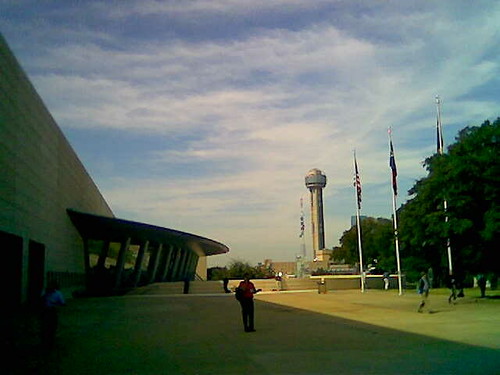Educause 2006 – day 1
Here I go with some reflections on the conference. You can find a lot of pictures on flickr to get a sense as to what the event looked like.

The first day opened with a big general session, Uncovering the Science in Computer Science: Challenges for the 21st Century – Vinton G. Cerf. He had an interesting outfit (captured here by this guy who was blogging 2 rows in front of me) that only reinforced my impression of him as a cooky (meant in the warmest way) computer science professor. He talked about how computer storage and processing power has grown exponentially but programming speed has not had nearly as great a multiplier. Towards the end he came to his focus of how sputnik gave the big push to K-12 science and technology education (not to mention the creation of the internet) and now global warming is the next sputnik. The global warming crisis should spur another K-12 push and more computing power is needed for simulations. After that he had a little sidenote about an Interplanetary Internet that really blew my mind. He’s working on protocols to allow satellites to act as network nodes for transfering data (packets) through space. With 4 satellites around Mars we’ll have a 2-planet Internet eventually.
Providing a nice bookend to my talk on Thursday, I attended Student Evaluations: A Comparison of Online vs. Paper Data Collection at 10:30 AM. This was a comparison done at the U of M just next door to Augsburg! I was reassured as they found similar trends that we have. Their 4 questions were:
- Is the completion rate different?
Uh, yes. 55.9% online vs 76.7% paper in their 314 course pairs. - Is there a difference in distributions?
Yes, but…. On their 7-point scale they had more 1,2,3 and 7s online. But just a little more. The distributions still look the same. The middle wasn’t completely absent, just a little absent. - Is there a difference in average ratings?
No significant difference in means. - What are the common perceptions of each format for faculty and students?
Using focus groups they heard typical comments. Check their resources for more details.
This is a good study to add to anyone’s list of resources.
Next up at 11:40 AM was From Labs to Collaborative Spaces: Development of Temple University’s TECH Center. This was a huge consolidation of 120 labs throughout the instituion. There was a lack of classroom spaces and rooms needed to be reclaimed. The resulting space is awesome. The Teaching & Learning Center, an “ask a librarian” service, as well as Admissions is housed there. For students there is a 24-hour help desk, a cyber cafe 13 breakout rooms, 6 specialized labs. In total there are 600 desktops and 100 laptops in the space. It’s been a big hit for recruitment as well as the prime spot for students to work all hours of the day. You can see more at http://www.temple.edu/cs/techcenter/. It really addresses the needs of an urban institution with a large non-resident population. It gets me thinking about how we address the needs of our non-resident students.
The afternoon brought the 2:15 PM session The Changing Place of Space. The now well-known Emory University Cox Hall project is used to provide guidance to Emory’s next building project. The session gave some good suggestions — combining curricular and co-curricular activities, quality matters, it takes a campus to support learning spaces, establish standards, focus on everything. They have many pictures on flickr.
Before poster sessions, the day wrapped up with a 3:50 PM session Letting Go of ResNet. Three small colleges (2 with old old residental networks) contracted with Apogee to run their residential networks. Though it did feel like a bit of an ad for Apogee, the colleges did find their staff could now focus on issues really about education. Students get a free basic bandwidth service (64 kbps) to the internet but could upgrade speeds for a cost. They get a fat pipe (100 mbps) to campus resources for free too. It does look attractive as resnet is becoming a bigger and bigger distraction to IT departments. However it is not cheap — Apogee’s website notes $3-$20 / bed / month. But once you calculate the staff time spent (by multiple fulltime staff) on resnet issues it might not seem so bad.
Leave a Reply